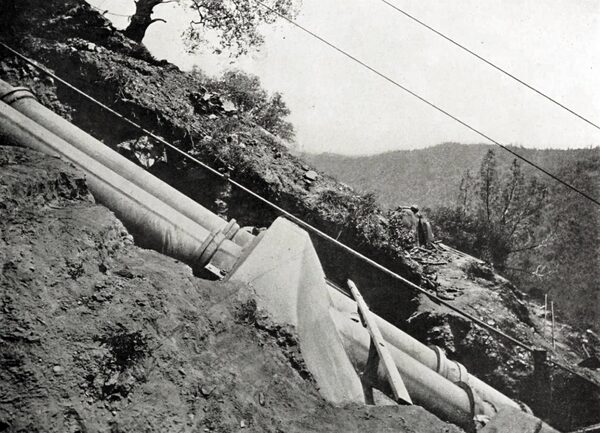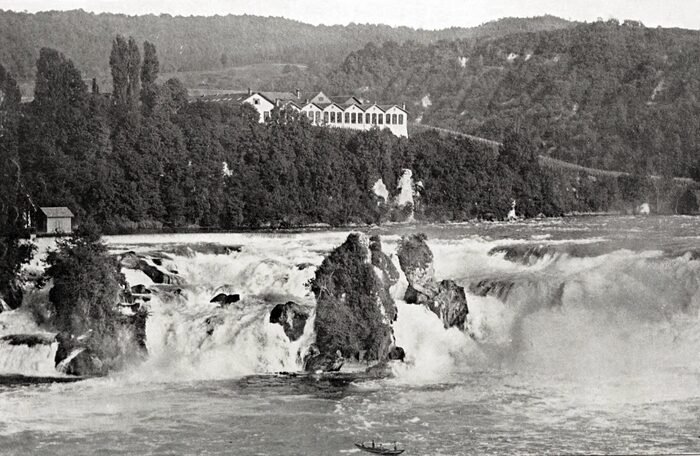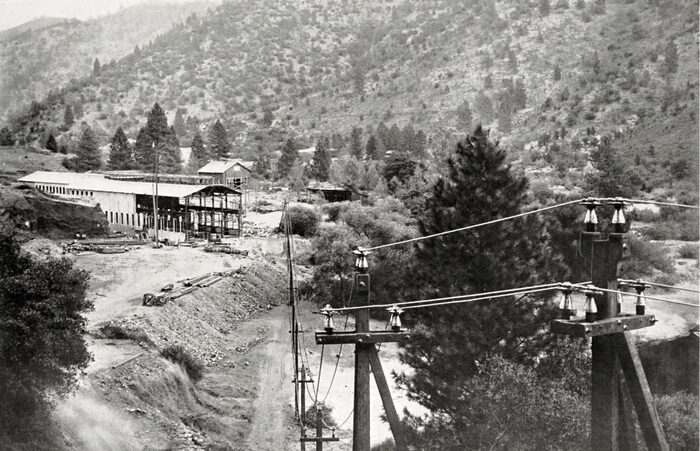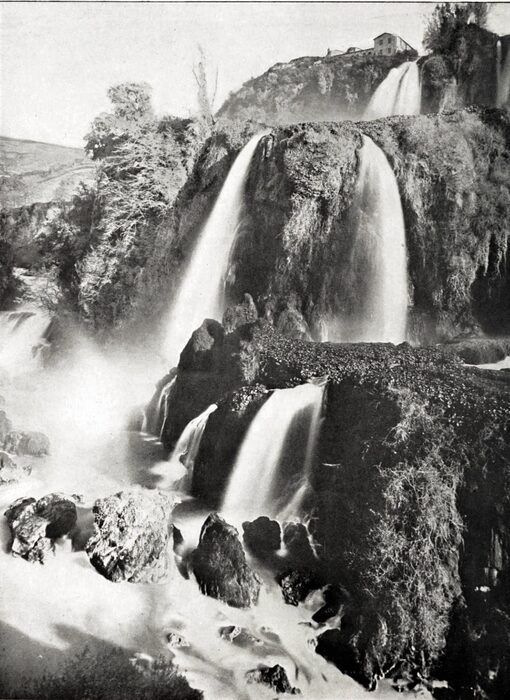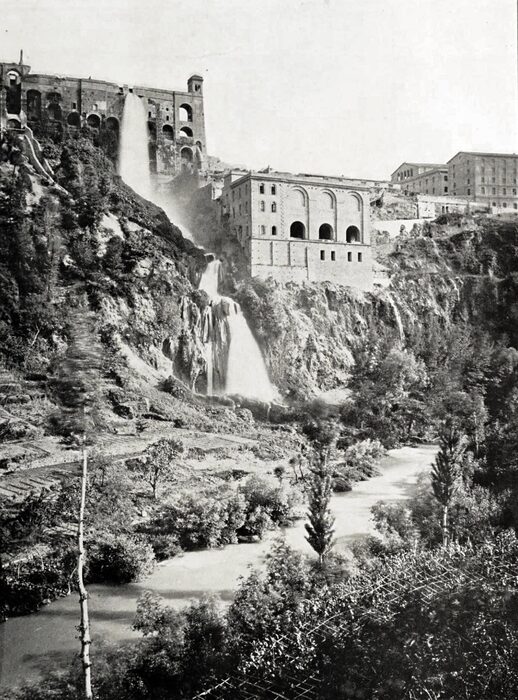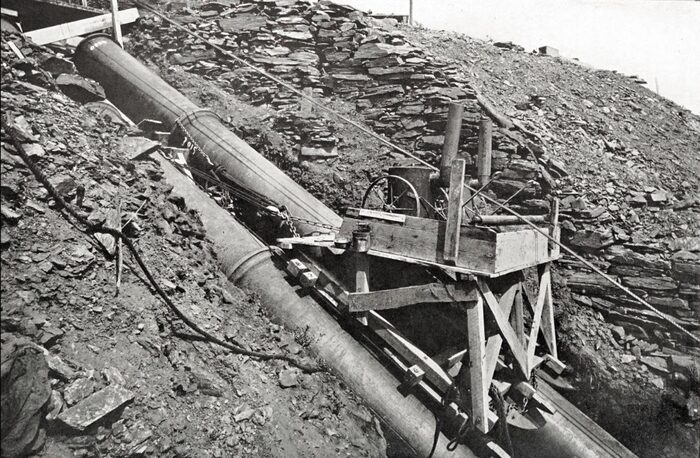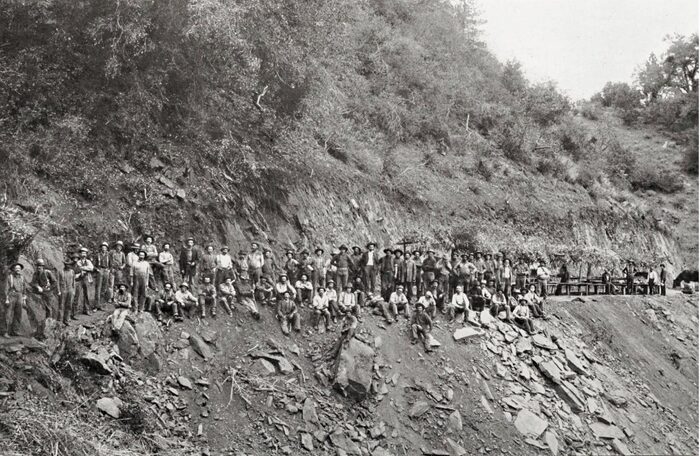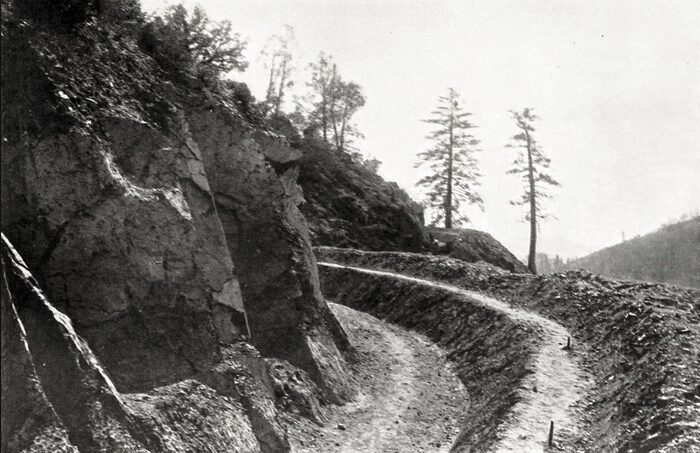[Trade Journal]
Publication: Electrical Age
New York, NY, United States
vol. 32, no. 6, p. 345-356, col. 1-3
Large Water-Power Electric Installations
By DR. F. A. C. PERRINE
THE development and use of the waterfall is a subject not only of vital industrial importance, but also one of fascinating interest. Whatever charm the subject may have generally, it is much more worthy of attention and more picturesque when viewed from the standpoint of electrical development, which goes hand in hand with a preservation of the scenic effects, while affecting important social and industrial improvements. Young men have been the pioneers in this industry, and are yet to-day among its foremost workers. There has been no region too remote and no problem too difficult for their energies and ambition.
| |||
| An Anchoring Pier on A Mountain Side Pipe Line Belonging to the Hydraulic Plant of the Standard Electric Company of California. |
But before attempting to present the picturesque view of this work that is so intensely interesting from every side, it is well to stop and consider why we should be especially proud of the work that has been done, beyond the pride that we feel in winning success for ourselves and taking part in making nature do our work for us. Without thought, it is often the custom of some to consider and arraign the development for power purposes of the streams of a country as but a form of industrial vandalism. Such a belief or feeling can now be held only by the thoughtless and unobserving. John Ruskin, during many years of his life, bitterly arraigned the commercialisms of his day, blaming mechanical inventiveness and progress for what he saw about him worthy of blame. He undoubtedly placed his finger on many sore spots in our (lay of progress, and about his teachings a school has developed which has accomplished much in spite of the fact that many of his fears and forebodings were groundless. The hideous characteristic of commercial growth about which he complained was but one of the accompaniments of new growth, for to-day we cannot call modern commercial, industrial and mechanical progress old.
One hundred years is surely a short period in the world's history, and yet the birthday of the steam engine as applied to manufacture dates back only to the spring of 1786. The first fifty years of the nineteenth century marked the introduction of all we know as manufacturing, while the last fifty years of that century developed practically all of the machinery we use to-day. Is it strange, then, that accompanying the birth of so many new ideas, and being engaged in their rapid development and introduction, those concerned with this work should use the machinery first in the crudest and most temporary manner, hesitating to build and plan as though in the belief that what they were doing was other than experimental?
With much of the crude mechanical application completed, we are now during the present century devoting our time and talents and using our opportunities for the development of the comfortable and artistic. Surely, no one who has for any period of time considered the products of manufacture can fail to notice and acknowledge this advance.
| |||
| The Falls of the Rhine at Neuhausen, Switzerland. Three Thousand Horse-Power Are Here Developed and Used in the Making of Aluminum |
| |||
| High-Tension Transmission Line Leaving the Power House at Electra of the Standard Electric Company of California |
The electrician has come forward with his inventions in hand to remove the factory from the bank of the stream to a location where the health and comfort of the operative can be considered, and he has established the factory where there is a possibility of lifelong occupation with less of dirt and danger than ever could have been accomplished in any other manner. Beyond the factory, too, the influence reaches far, for in the development of every horse-power of water energy made available by such means, there are at least 12 tons of coal less per year that it is necessary to mine for doing the world's work; by reason of each of the 1000-H. P. generators that the electrical companies are sending out every year in numbers there arc 12,000 tons of coal less to be mined per year, and not Tor one year only, but for every year the machine continues in operation. The waterfall has been called the white coal mine; the miners, the stokers; the coal passers being the sun, the winds and the rain which continually replenish the river's source.
Not only in its generation, but in its application, is the electrical development of the water-power important. It surely must be evident to all how important an element in the disintegration of the crowded and squalid portions of cities is the extension of electric traction, and, further, the use of electrical power that may be distributed to great distances and applied in small quantities is rendering the small manufacturer more independent of the large one, an effect which in our country is only just becoming apparent and important, but which in some localities (as notably at Geneva, Switzerland) has had a marked effect on the character of trade, and has enabled the home-worker to continue in competition with the factory. Do not think that what has been said is an apology for electrical water-power development. On the contrary, it has been said in the hope of calling to your attention neglected facts that are about you and the importance of work that has been (lone in your midst.
| |||
| The Lower Portion of the Main Pipe Line of the Standard Electric Company of California |
The development, transmission and distribution of the power of the waterfall have resulted from the continuous study and work of the electrical discoverers, inventors and engineers during a period of about seventy years, every year of which has been important to the result attained, though the last ten years have produced the most striking of the practical results. During this period the advance has been so rapid as to astonish even the most sanguine and enthusiastic prophets of advancement.
The art of the electrician, as we know it to-day, began in 1832, when Faraday, working in his laboratory at Cambridge, England, discovered the principle of the production of electricity from magnetism, and laid the foundation for the invention of the dynamo-electric machine. In the year following, at Albany, N. Y., Joseph Henry discovered the principles that are now embodied in the transformer, and with the foundations for the art thus laid, the inventions began.
Gradually the machinery has developed, until suddenly and accidentally the reversibility of the dynamo was discovered at the Vienna Exposition of 1873, and the whole field of electric-motor working was opened up, for the reversed dynamo is the motor. Then began the study of the application of electricity as a motive power. In the early days attention was being given almost exclusively to lighting problems, and it was not until the early eighties that the motor became a really important machine. About that time in California. in Switzerland and in Northern Italy, beginnings were made in the electrical use of the waterfall, but the present solution of the long-distance problem has been based upon the discoveries of Ferraris in the later eighties. The work of this Italian pointed out the manner in which the alternating motor could best be made, and how that beautifully simple generator, the alternator, which has no sparking commutator, and if necessary no moving wire, could be utilized for power purposes.
Furthermore, the experiments of Henry and his successors had shown how the pressure of the alternating current could be raised or lowered without moving apparatus, and this resulted finally in the development of the simple transformer.
The first American plant utilizing all of these elements was installed by the Stanley Company at Housatonic, the current being transmitted to the Monument and Great Barrington. This was in 1893. From these small beginnings the art has rapidly advanced, the engineers and inventors working together and viewing with each other, till now there seems no problem too difficult or startling for them to attempt together.
| |||
| The Electric Street Railway and Lighting Service of Rome is Supplied in Large Part From the Falls at Tivoli, Seventeen Miles Away, With An Available Head of 360 Feet |
The most startling and picturesque work has been carried out on the Pacific Coast, a land of no coal and little water, but in which the rivers flowing to the sea descend with most startling rapidity, permitting the development of great powers from insignificant streams. Over and through the central part of the State there runs a network of transmission lines fed by machinery designed and manufactured in Pittsfield. In this region many falls have been utilized, and the current is transmitted to great distances for the operation of lighting plants, railroad and mills. Here the season of practically no rain is long and must be guarded against by the storage of water in the mountain lakes of the high Sierras at elevations of from 6000 to 9000 feet. From these lakes the water falls into the bed of the rivers where it flows among the high mountains and through the deep canons until it is caught and carried along the mountain sides through ditches and along the face of high precipices in timber flumes, until a point is reached where the difference of level between the ditch and the river is sufficient, and the site favorable for the location of the power house, when with a bold leap the water is carried in iron pipes down the mountain side to the power house, where with immense force it plays on the buckets of the wheels in a stream of great power. These jets of water, spouting under pressures of from 300 to 700 pounds per square inch, seem now to have almost lost the character of ordinary water and to have become a different substance.
Nothing built will resist the terrible tearing force they develop. The moving mountains and the filling of rivers and harbors is a tale familiar to all from the stories of mining days, but even a knowledge of this does not enable one to realize the force so much as does the fact that these jets will wear away and tear apart riveted shells of boiler iron; a stream no larger than your smallest finger will pierce and kill a man as quickly almost as a shot from a gun; the skin will be stripped from the hand if laid for an instant along the side of the stream, and a stone or board thrown into it will rebound as from a surface of rubber, it being thrown many feet away.
The scenes about these power houses are of great beauty, and are filled with many spectacular features. As one approaches one hears coming up the canon a continuous humming sound as of many bees, for the machines that one sees here in the power house once in operation are running continuously for weeks and months at a time. One can hardly realize that in this bright power house, with no confusion or dirt, and little evidence of what one ordinarily associates with machinery, current is being generated for the operation of lights and cars and mills in cities many miles away, where annually the use of many thousands of tons of coal is being dis-placed.
| |||
| The Hydraulic Power House at Tivoli |
In some ways the transmission of the current presents more startling feats of engineering than the generation of the current itself; poles, wires and insulators must he brought many miles into the mountains, distributed at inaccessible spots over a hostile country, and then after a right of way has been cleared through the forests the task of erection requires great skill and the ability to overcome obstacles of startling variety. At times the poles must be set in river beds by cementing to mounds of rock so that they will not be carried away during the spring floods; at other points the line must be swung across canons, at times in spans exceeding one-quarter of a mile in length, and always stretching away over hills and valleys to the far distant city in a course as straight as possible. This is no hap-hazard work such as is often seen in the construction of the telegraph and telephone lines about us here, for the success of a transmission plant depends upon the permanence and continuity of its service, for the attainment of which the greatest precautions are taken in the clearing of the right of way and providing for a continuous patrol, inspecting and guarding the lines.
| |||
| \"Leading\" the Joints on the Pipe Line of the Standard Electric Company of California. the Furnace and Truck Travelled on Top of the Pipes, Using Them As Tracks |
In the cities themselves simple substations are used for the distribution of the current, where often large amounts of power are made available without any accompaniment of dust or dirt and in a space much less than could avail for the steam engine doing a similar amount of work.
On the Pacific Coast nothing is considered high head when the pressure is less than 100 pounds per square inch, representing a fall of water of about 200 feet, and from such heights the heads increase to a maximum of about 2000 feet, which represents almost the maximum in the developments accomplished up to the present time.
It will be interesting now to examine one that is almost the extreme in the opposite direction, and for that purpose we will take a glance over the plant at Sault Ste. Marie, Mich. To be sure, the financial difficulties of the company developing this power have lately attracted much attention. but we are now discussing engineering and not finances. Of engineering of a high order there has been no lack at the Sault.
In carrying the water of Lake Superior around the St. Mary's Rapids to the power house below them, where the small head of 18 feet is being utilized, one of the deepest and widest canals of the world has been built, 25 feet deep and 210 feet wide. This canal curves around the back of the town, emptying into St. Mary's River through the power house which has been built across the forebay at the end of the canal, the house itself being 1465 feet long, over a quarter of a mile. In this great power house eighty small generators, each of 400 H. P., are set, each being directly coupled to four water-wheels set without any flumes or pipes directly in the waters of the forebay itself.
The difficulties encountered in the development of this great power plant have been those of handling such a great volume of water, hut, ill spite of the great difficulties that have been met, the cost of the whole work has not been excessive, and when this plant is entirely completed there need be no fear of drought or flood, for from that greatest of storage reservoirs, Lake Superior, the flow at all seasons is remarkably constant, and at times sufficient for the generation of above 100,000 H. P.
| |||
| Two Thousand Men Were Employed in Digging the Ditch of the Standard Electric Company |
Some of the most beautiful natural scenery surrounding power developments is to be found in our neighboring State of Mexico. There the characteristic plant is one with a diverting (lam in the river, a large canal along the mountain side, and a water head at the wheels of from 80 to 100 feet. The work done in Mexico is of a surprisingly stable character; in every point of detail the extensive use of hand labor is made manifest, whether in dams, canals or power houses, all of which is warranted by the fact that the fuel supply of Mexico is severely limited and the prices paid for power make large returns in revenue upon the investment in the power plants.
Let us not think that the development that has been made covers either the needs or the opportunities of the present day or that the installations now being undertaken are simply those of which consideration has been previously suspended on account of more favorable opportunities of power development at other locations. On the contrary, among the developments now being studied are some of whose importance there has been an early appreciation. It is true that by reason of the advancement in electrical machinery for the development, transmission and utilization of energy, there is now a possibility of larger stations than in any previous period of the world's history, and, furthermore, the question of accessibility and nearness to market is less important than heretofore; since there is now almost no limit to the size of development that may be successfully undertaken, though ten years ago there was hardly a 5000-H. P. water-power plant in the country, and to-day transmission distances up to 25 or 30 miles are considered short.
At present engineers are engaged upon the studies for a plant of great magnitude on the Potomac River, at the very point where George Washington was engaged as a civil engineer before he entered Braddock army.
| |||
| The Finished Water-Power Ditch of the Standard Electric Company of California Prior to Admitting Water |
The great falls of the Potomac operated flour mills before the revolution, and Benjamin F. Butler devoted much of his time and money toward securing control of all the power rights, leaving to his heirs a property that soon will be utilized in operating the lights and railroads of the city of Washington. The great falls of the Potomac River present engineering difficulties on account of the great fluctuations in the flow of the stream and on account of the peculiar fact that below the falls the river enters a narrow gorge about 2 miles in length where, during flood periods, the variation in the river's depth is as much as 60 feet. Only after continued study of the situation has a plan been evolved overcoming these difficulties by running a long canal and tunnel completely around the gorge and locating the power house at a point where the river widens and the ebb and flow of the flood waters is not great.
I trust that I have here given some slight idea of the problems that engineers have overcome, and have, at the same time, given some insight into the fascinating side of their work, facing nature in all her moods—facile, fickle and wild—and ever benefiting those abroad as well as those at home for all the future.

